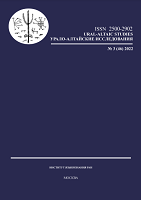Макроструктурный анализ повествовательных текстов тюркоязычных школьников-билингвов
Macrostructural analysis of narrative texts of Turkic-speaking bilingual schoolchildren
Author(s): Amirkul Sh. Amanov, Natalia V. GagarinaSubject(s): Sociolinguistics, Cognitive linguistics, Cultural Anthropology / Ethnology, Sociology of Culture
Published by: Институт языкознания Российской академии наук
Keywords: Bilinguals; macrostructure of stories; closely related languages; narrative skills; story; retelling;
Summary/Abstract: The present study is devoted to the analysis of the macrostructure of oral narrative texts of Turkic-speaking bilingual schoolchildren. The research material was obtained using a MAIN — Multilingual Assessment Instrument for Narratives — a tool for assessing the narrative abilities of bilinguals. Subjects for the analysis represent the most common language groups among children in Kazakhstan. The results of the study differ significantly from previous findings regarding the ratio of qualitative and quantitative indicators of the macrostructural complexity of bilingual stories in two languages, as well as in the comparative description of the features of closely related languages, their connections, similarities and differences in the conditions of bilingualism and multilingualism. Observations show that narrative competence develops depending on the subject’s age and propensity for storytelling and becomes fully structured only in the adulthood. Children begin to create narratives at about two years old, and from that moment their narrative competence develops intensively, although at different rates speed. A closer look at the various macrostructural components showed that the production was strikingly similar in the three language groups, both for frequently used and rarely encountered components of the macrostructure. The complexity of the plot was also considered from the other side — by estimating the number of episodes in which participants implemented complete GАО sequences. In all three language groups, on both L1 and L2, most speakers used at least one complete sequence. Nevertheless, it becomes clear that when conducting scientific research on bilingualism in the republic, it is necessary to take into account the regional socio-economic, demographic and ethno-linguistic conditions that have historically developed on the vast territory of the country.
Journal: Урало-алтайские исследования
- Issue Year: 2022
- Issue No: 03 (46)
- Page Range: 7-20
- Page Count: 14
- Language: Russian

